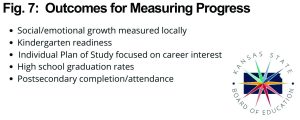Kansas state school board member misrepresents SEL position
(The Sentinel) – At the August board meeting, Kansas state school board member Ann Mah misrepresented a social-emotional learning (SEL) statement she attributed to Stand Together. …

(The Sentinel) – At the August board meeting, Kansas state school board member Ann Mah misrepresented a social-emotional learning (SEL) statement she attributed to Stand Together.
Mah claimed that a report she received from Stand Together said, “Schools that prioritize social-emotional learning have better academic outcomes.” But that is a conscious misrepresentation.
Grant Hewitt, Vice President of Foundational Education at Stand Together, says their work does not attempt to connect SEL with better academic outcomes. Stand Together says SEL should be available for the parents who want it.

“SEL environments would absolutely be a part of that marketplace. We should not force SEL on anyone, nor should we prevent anyone from selecting these environments.”
However, the Kansas State Board of Education does force SEL on parents and students. School district accreditation includes a requirement to measure students’ social-emotional growth.
Mah misrepresents Stand Together on microschools
In an email exchange with the Sentinel in which Mah confirmed her claim about SEL being linked with better outcomes, she also said disagreed with Stand Together’s support for microschools.
“We think that all students deserve the best education and that public schools can provide the tools, resources, and strategies needed for student success when we are properly funded and supported.”
But Hewitt says Stand Together doesn’t promote microschools as the answer.
“We don’t suggest that microschools are the solution. Rather, we suggest they could be something good for some families. Just as I would suggest that a traditional private school might be good for some families, or even a charter school might be great. The core principle here is a free market that embraces pluralism in education. At Stand Together we are careful not to suggest that any delivery model is better than another. Rather, we suggest you should let 1,000 flowers bloom and allow families the freedom to pick what is best for their child.”
Mah routinely uses the ‘not enough funding’ excuse when achievement comes up, even though no evidence exists that says spending more money translates into better achievement. There is a mountain of evidence to the contrary, however.
Most recently, the Sentinel’s parent company, Kansas Policy Institute, published it’s annual productivity analysis of all 50 states to see which get the best ‘bang for the education buck.’
Kansas’ composite score on the 2022 National Assessment of Educational Progress (NAEP) is 243 for the eight main measurements (4th-grade and 8th-grade reading and math for low-income students and everyone else), whereas the national average is 246. Per-student spending for 2021, adjusted for the cost of living, is $19,451. Productivity is determined by dividing spending by the NAEP composite score, which, for Kansas, is $80 per NAEP point scored. At $80 per point, Kansas is ranked #42 in the nation.

Once again, the data disproves the education lobby’s claim that spending more money is the key to achieving better outcomes. For example, 31 states have the same or better NAEP composite as Kansas but spend less per student.
Here’s another example. Ten states have a 247 NAEP composite, but spending goes from a low of $10,595 per student in Utah to $23,568 per student in New York.
Even the Kansas Supreme Court says schools are adequately funded, and the money keeps increasing while achievement remains unacceptably low. The 2022 state assessment results show there are more Kansas students below grade level in reading and math than are proficient.
Sadly, Ann Mah’s deception is par for the course, as Kanas Policy Institute has documented on multipe occasions (see here and here for examples). Just the other day, she made a false statement to the Topeka Capital-Journal about school funding.
“They’re figuring they do a $5,000 average per kid for general education, so they could do something similar for special education.”
She knows that state aid is more than twice what she implied. The Kansas Department of Education says state aid per student was $10,800 for the 2022 school year, of which about $7,900 was distributed on a per-student basis.
Deception on the part of state school board members, the Department of Education, the state school board association, and other education officials is rampant in Kansas. School districts have been caught violating state law, and the state school board does nothing. There are a lot of dedicated teachers and other school employees who are doing everything they can to help students, but their efforts are limited by some administrators and board members.
Mah is right about one thing, however. Microschools alone are not the answer; getting kids the education they deserve takes an ‘all of the above’ approach that includes microschools and robust money-follow-the-child programs. We know from the experience in other states that the vast majority of parents will choose a public school, so the Legislature must also enact transparency and accountability measures, and eliminate burdensome regulations to allow students to flourish.



